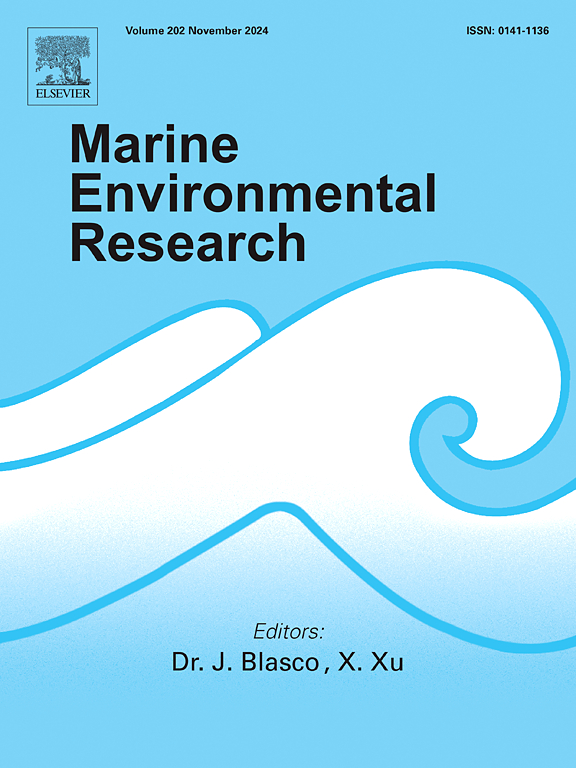热应激对南极冰鱼(Chionodraco hamatus)和红血鱼(Trematomus bernachii)胸骨肌的影响。
IF 3.2
3区 环境科学与生态学
Q2 ENVIRONMENTAL SCIENCES
引用次数: 0
摘要
南极硬骨鱼是极端低温物种,生活温度接近海水冰点(-1.9°C),年波动小于1°C。海洋变暖的加剧使所有物种都面临压力,包括氧气供应减少。因此,热应激对南极鱼类形态功能特征的影响正受到密切关注,特别是那些没有血红蛋白(Hb)的物种。本研究分析了急性热应激对两种南极硬骨鱼——血源性bernacchii螯虾(Trematomus bernacchii)和无血源性螯虾(Chionodraco hamatus)胸肌形态、细胞凋亡以及参与血管运动和热休克反应的分子表达的影响。热应激后,我们观察到两种动物的胸肌结构发生了变化。特别是,冰鱼的血管更大,血管更发达。通过免疫定位,我们证实了内皮型一氧化氮合酶(eNOS)、血清素(5HT)、囊泡型乙酰胆碱转运蛋白(VAch)和热休克蛋白90 (HSP90)的表达和定位存在物种特异性差异,这些蛋白在暴露于4°C后似乎会上调。此外,利用TUNEL技术,我们发现热应激后的冰鱼有更多的凋亡细胞核。除了显示两种南极硬骨鱼的胸肌对热应激的特定反应外,我们的研究结果表明,不含hb的鱼类更容易受到变暖的影响。本文章由计算机程序翻译,如有差异,请以英文原文为准。
Effects of heat stress on the pectoral skeletal muscle of the Antarctic icefish Chionodraco hamatus and the red-blooded Trematomus bernacchii
Antarctic teleosts are extreme stenotherm species living at temperatures near to sea water freezing point (−1.9 °C), with annual fluctuations of less than 1 °C. Increasing ocean warming exposes all species to stressful conditions, including decreased oxygen availability. Therefore, the impact of heat stress on morpho-functional traits of Antarctic fishes is receiving intense attention, particularly concerning species without haemoglobin (Hb). In this study, were analyzed the effects of acute heat stress on the pectoral muscle of two Antarctic teleosts, the red-blooded Trematomus bernacchii and the Hb-less Chionodraco hamatus, on morphology, apoptosis and expression of molecules involved in vascular motility and heat shock response. After heat stress, we observed structural changes in the pectoral muscle of both species. In particular, those of icefish appear more vascularised with larger vessels. By immunolocalisation we evidenced species-specific differences in expression and localisation of endothelial nitric oxide synthase (eNOS), serotonin (5HT), vesicular acetylcholine transporter (VAch) and Heat Shock Protein 90 (HSP90) that, after exposure to 4 °C, in icefish seem to be up-regulated. Moreover, using the TUNEL technique, we found more apoptotic nuclei in the icefish after heat stress. Besides showing species-specific responses of pectoral muscle to heat stress in the two Antarctic teleosts, our results suggest a greater vulnerability to warming of Hb-less fish species.
求助全文
通过发布文献求助,成功后即可免费获取论文全文。
去求助
来源期刊

Marine environmental research
环境科学-毒理学
CiteScore
5.90
自引率
3.00%
发文量
217
审稿时长
46 days
期刊介绍:
Marine Environmental Research publishes original research papers on chemical, physical, and biological interactions in the oceans and coastal waters. The journal serves as a forum for new information on biology, chemistry, and toxicology and syntheses that advance understanding of marine environmental processes.
Submission of multidisciplinary studies is encouraged. Studies that utilize experimental approaches to clarify the roles of anthropogenic and natural causes of changes in marine ecosystems are especially welcome, as are those studies that represent new developments of a theoretical or conceptual aspect of marine science. All papers published in this journal are reviewed by qualified peers prior to acceptance and publication. Examples of topics considered to be appropriate for the journal include, but are not limited to, the following:
– The extent, persistence, and consequences of change and the recovery from such change in natural marine systems
– The biochemical, physiological, and ecological consequences of contaminants to marine organisms and ecosystems
– The biogeochemistry of naturally occurring and anthropogenic substances
– Models that describe and predict the above processes
– Monitoring studies, to the extent that their results provide new information on functional processes
– Methodological papers describing improved quantitative techniques for the marine sciences.
 求助内容:
求助内容: 应助结果提醒方式:
应助结果提醒方式:


